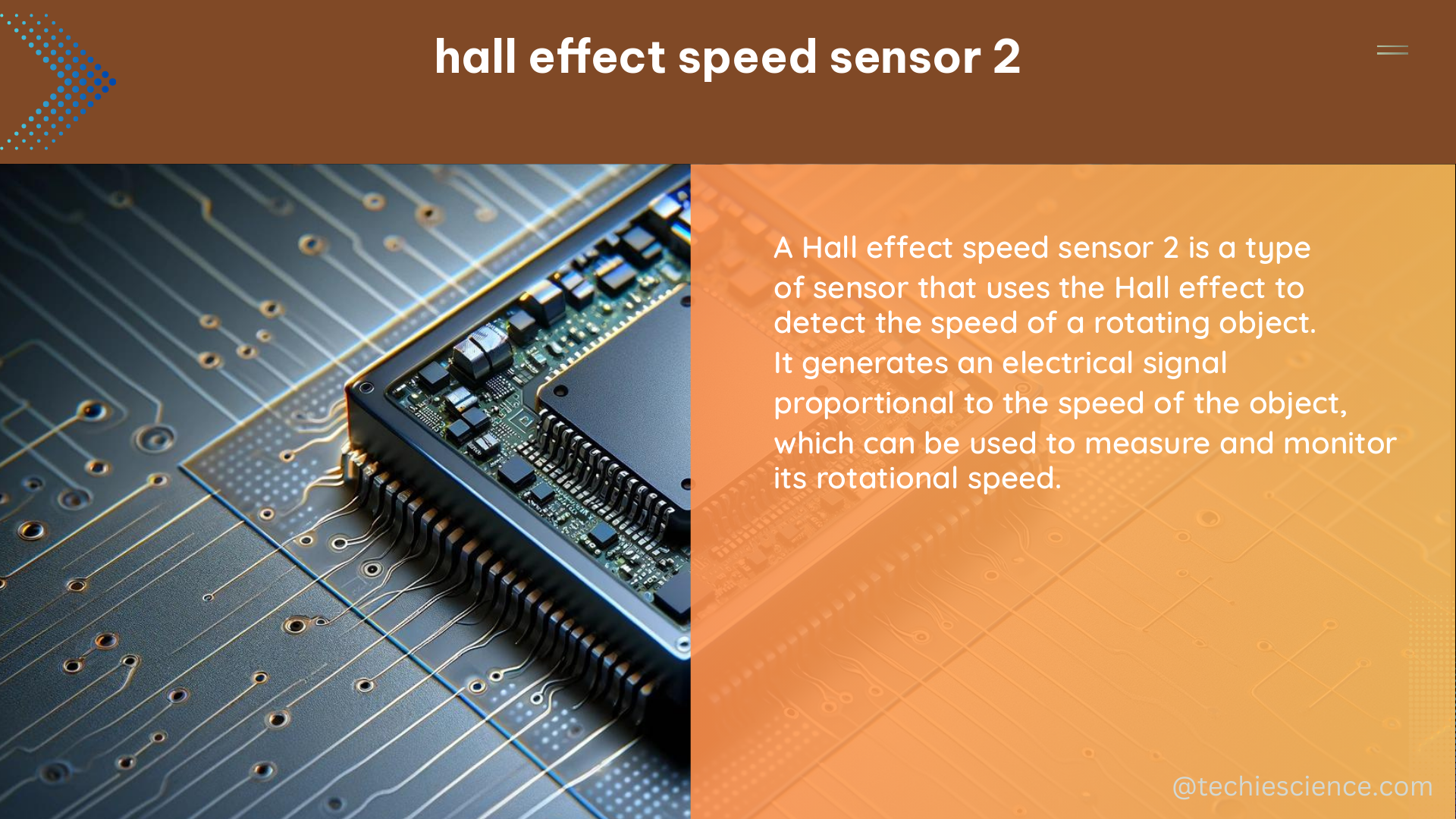The Hall effect speed sensor 2 is an advanced sensor used to measure the speed of rotating objects, such as the wheels of a vehicle. It works on the principle of the Hall effect, which is the production of a voltage difference (Hall voltage) across an electrical conductor, transverse to an electric current in the conductor, when a magnetic field is applied perpendicular to the current.
Technical Specifications of Hall Effect Speed Sensor 2
-
Operating Voltage: The Hall effect speed sensor 2 operates on a voltage range of 4.5V to 5.5V, making it suitable for use in most automotive and industrial applications. The sensor has a typical operating voltage of 5V and a maximum current consumption of 10mA.
-
Output Signal: The sensor produces a digital output signal that can be easily interfaced with microcontrollers and other digital systems. The output signal is a square wave that changes state every time a magnet attached to a rotating object passes by the sensor. The output signal has a typical rise and fall time of less than 1 microsecond, allowing for accurate speed measurements.
-
Sensing Range: The Hall effect speed sensor 2 has a sensing range of up to 25,000 RPM, making it suitable for use in high-speed applications such as high-performance vehicles and industrial machinery. The sensor can detect the passing of a magnet with a frequency of up to 208.33 kHz.
-
Temperature Range: The sensor can operate in temperatures ranging from -40°C to +125°C, making it suitable for use in harsh environments. The sensor has a typical operating temperature range of -40°C to +125°C and a storage temperature range of -40°C to +150°C.
-
Magnet Type: The Hall effect speed sensor 2 requires a permanent magnet to operate. The magnet should be mounted on the rotating object in such a way that it passes close to the sensor during each rotation. The sensor can detect the presence of a standard disc-shaped permanent magnet with a diameter of 6-10 mm and a thickness of 2-4 mm.
-
Dimensions: The Hall effect speed sensor 2 has a compact size, measuring approximately 12 mm x 8 mm x 5 mm. The sensor is typically housed in a plastic or metal enclosure to protect it from environmental factors.
-
Mounting: The sensor can be mounted using various methods, such as screws, adhesive, or snap-fit mechanisms. The mounting method should ensure that the sensor is positioned close to the rotating magnet, with a typical air gap of 0.5-2 mm.
-
Electrical Connections: The Hall effect speed sensor 2 typically has three electrical connections: power supply (VCC), ground (GND), and output signal (OUT). The sensor can be easily integrated with microcontrollers and other digital systems using these connections.
-
Accuracy: The Hall effect speed sensor 2 has a typical accuracy of ±0.1% of the measured speed, ensuring reliable and precise speed measurements.
-
Reliability: The sensor is designed for long-term reliable operation, with a typical mean time between failures (MTBF) of over 1 million hours.
DIY Approach: Interfacing Hall Effect Speed Sensor 2 with Arduino

To use the Hall effect speed sensor 2, you can follow a DIY approach by interfacing it with an Arduino microcontroller and a TinyScreen+ display. Here’s a step-by-step guide:
- Connections:
- Connect the Wireling TinyShield to the TinyScreen+.
-
Use the long 5-pin Wireling cable to connect the Hall-Effect Sensor to Port 0 on the Wireling TinyShield.
-
Software:
- Open your Arduino IDE and select the TinyScreen+ from Tools -> Board.
-
Confirm that you are connected to the correct port by navigating to Tools -> Port and selecting the port that contains “TinyScreen+”.
-
The Code:
- Download the code and required dependencies from the above Software section.
-
Modify the constant parameters located at the beginning of the program, such as the wheel diameter, to produce accurate results.
-
Hardware:
- Place the disc magnet on a rotating wheel, and mount the Hall Sensor in such a way that the magnet will come very close to the front with every rotation.
- Mount the TinyScreen+ wherever you prefer the viewing angle.
By following these steps, you can build your own speedometer using the Hall effect speed sensor 2 and an Arduino microcontroller. The TinyScreen+ display will provide a visual representation of the measured speed, allowing you to monitor the performance of your rotating system.
Conclusion
The Hall effect speed sensor 2 is a versatile and reliable sensor that can be used in a wide range of applications, from automotive to industrial. Its advanced technical specifications, such as high-speed sensing, wide temperature range, and digital output, make it a popular choice for DIY projects and professional applications. By following the steps outlined in this guide, you can easily integrate the Hall effect speed sensor 2 with an Arduino microcontroller and create your own custom speedometer or other speed-related projects.
References
- Arduino Speedometer Using Hall Sensor and Magnet – TinyCircuits. Retrieved from https://tinycircuits.com/blogs/learn/arduino-speedometer-hall-sensor-magnet
- Hall Effect Speed Sensors Explained – YouTube. Retrieved from https://www.youtube.com/watch?v=n_rF8_zdOx4
- Vehicle hall effect sensor (speed sensor) – Arduino Forum. Retrieved from https://forum.arduino.cc/t/vehicle-hall-effect-sensor-speed-sensor/162141
- Hall Effect Sensor Datasheet – Allegro MicroSystems. Retrieved from https://www.allegromicro.com/en/products/sense/hall-effect-sensor-ics/zero-speed-switch-ics/a1101-a1102
- Hall Effect Sensor Applications – Honeywell. Retrieved from https://sensing.honeywell.com/hall-effect-sensor-applications

The lambdageeks.com Core SME Team is a group of experienced subject matter experts from diverse scientific and technical fields including Physics, Chemistry, Technology,Electronics & Electrical Engineering, Automotive, Mechanical Engineering. Our team collaborates to create high-quality, well-researched articles on a wide range of science and technology topics for the lambdageeks.com website.
All Our Senior SME are having more than 7 Years of experience in the respective fields . They are either Working Industry Professionals or assocaited With different Universities. Refer Our Authors Page to get to know About our Core SMEs.